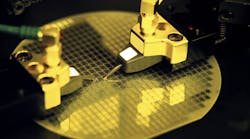For years, Macom has viewed optical networking as its ticket into telecommunications infrastructure. To complement its wireless components, the company has increasingly targeted the data centers that backstop wireless networks.
That shift continued Monday when the chip maker said that it had signed a $770 million deal to acquire Applied Micro Circuits, an Austin, Texas-based company that designs chips for linking and switching messages inside data centers, as well as the computer chips that drive the warehouse-sized calculators.
Applied Micro has been in the spotlight recently for making server chips based on the ARM architecture widely used in smartphones, tablets, and other low-power electronics. But the company’s appeal to Macom comes from its networking technology, including chips that modulate electrical signals and share high-speed messages between servers.
John Croteau, Macom’s chief executive, said in a conference call with analysts that Applied Micro’s networking chips were the “gold nugget” of the acquisition. He added that they fit with Macom’s existing optical networking business, which sells analog chips and silicon photonics to telecommunications and aerospace firms.
The deal also gives Macom access to big customers like Cisco Systems, which accounts for around a quarter of Applied Micro’s business. Other buyers of Applied Micro’s products include cloud equipment makers like Arista, and wireless networking firms like Nokia and Ericsson.
“Macom will now be able to provide all the requisite semiconductor content for optical networks – analog, photonic, and PHY – from the switch to fiber for long haul, metro, access, backhaul, and data center,” said Croteau in a statement.
Applied Micro’s technology holds weight in the optical networking market. Its chips employ a technology known as PAM4, which modulates electrical signals and weaves them into worms of light that travel over cable. The Institute of Electrical Engineers recently announced that an industry standard for optical networking should have the same capabilities as Applied Micro’s chips, which can transmit 100 gigabits per second over a single wavelength.
Croteau said that internet companies like Google, whose monolithic servers are responsible for powering its search engine and cloud computing business, will spring for PAM4 upgrades to squeeze more bandwidth out of their data centers. The new technology is still expensive, which Croteau hopes will increase Macom’s profit margins.
Croteau indicated that the deal had some rough edges, though. Macom plans to divest Applied Micro’s server chip business, which doesn’t fit into the company’s overall strategy, within the first 100 days after the deal is finalized. Both companies expect it to close in the first quarter of 2017.
“The business does not strategically align with Macom’s long-term focus,” the company said in a statement. “AppliedMicro has been exploring strategic options for the compute business and there is known strategic interest among several potential buyers and investors.”
Macom’s $8.36 offer represents a 15% premium over Applied Micro’s closing stock price on Friday, a relatively low premium in a wave of semiconductor industry’s consolidation that has forced companies to pay up to 30% over stock prices. The boards of directors of both companies have approved the deal.

